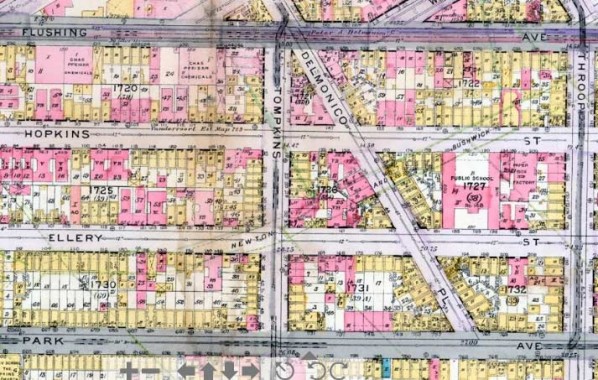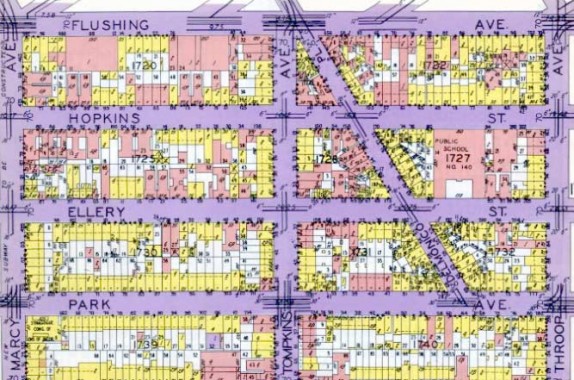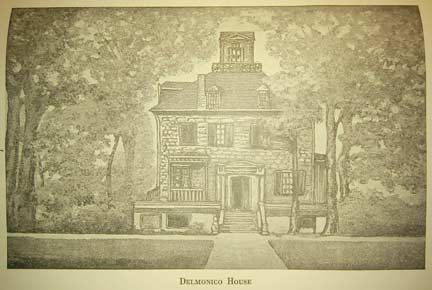There’s probably an interesting story behind the naming of Delmonico Place in Brooklyn’s Bedford-Stuyvesant, just below its undefended border with Williamsburg. It’s a one-block street on an odd slant between Ellery Street and Park Avenue, east of Tompkins. Unfortunately, I don’t know what that story is, but it would be notable if the street had anything to do with the famed NYC restaurant opened by the Swiss immigrant Delmonico brothers, John and Peter, that was, among other innovations, the first restaurant permitting patrons to order a la carte from a menu. The restaurant has opened and closed several times and operated from different locales around town, most notably from a narrow building at #2 South William Street that still has the Delmonico name chiseled over the entrance.

Delmonico Place turns up on official maps around 1900, but it likely existed before that. Originally it was a southeast extension of Harrison Avenue that ran three blocks, but with one lane to Harrison Avenue’s two. By 1916, it had arrived in full, as witness the individual houses, marked in pink and yellow, along its length.
It should be noted that the street was marked “Delmonico Place” from the beginning. Some mid-century maps had it as Harrison Avenue, but that may have been a scheme that failed.

By 1929 little had changed for Delmonico Place. However, note the presence of Public School 140 in both the 1916 and 1929 maps — it had a role in the diminution of the short street, making it even shorter. PS 140, later PS148, closed in 1985, with the building now educating special needs students.

By 2011, Delmonico Place is a remnant of its former self as two of its blocks have been demolished. Only the stretch between Ellery Street and Park Avenue remains. And, of the many buildings that formerly fronted on it, only one remains.
Delmonico Place was eliminated in stages. The block between Hopkins and Ellery Streets went first, then the block between Hopkins and Flushing Avenue. If you look at the spot where the street had been, running south from Flushing and Tompkins, you see a house oriented toward the angel that the street formerly took. Most amazingly the Department of Transportation has placed a Delmonico Place sign here, despite the fact that Delmonico Place has not run here for decades.
There are two explanations: The corner house actually has a Delmonico Place address, carried over from previous decades when the street actually ran here, or:
The DOT uses hopelessly outdated records and maps, which I’d imagine is the actual reason.
The path of Delmonico Place between Hopkins and Ellery Street is occupied by a concrete yard adjacent to PS 140 labeled Charlie’s Place. According to the Parks Department, the schoolyard opened in 1957, thereby eliminating the old stretch of Delmonico.
After the adjacent PS 148 closed in 1985 the yard remained empty for several years before it was reopened in 1992 as a play space for kids at the nearby Beginning with Children School (PS 333) which was partially funded by a benefactor named Sara Lee Schupf.
Sara Lee is the Sara Lee — her father was baker Charles Lubin (1903-1988) the founder, in 1949, of the Sara Lee brand of baked goods, which nobody doesn’t like.
Finally, at Ellery Street you come upon an actual stretch of Delmonico Place–the only block still remaining, just north of the Tompkins Houses on Park Avenue.
Only one building remains of the former dozens — a Jehovah’s Witnesses Kingdom Hall.
Forgotten Fan Paul Rush: What I think you’ve uncovered in your piece about Delmonico Place in Williamsburg is part of the driveway from the old Brooklyn-Newtown Road to the Delmonico farm and villa. This is also a reminder of the legendary Delmonico’s, for ninety years New York’s most celebrated restaurant. In 1834 the brothers John and Peter Delmonico acquired a country seat on the rural western end of Long Island. In largely open country they bought 220 acres of Williamsburg farmland for $16,000 and built an imposing Italian-style stone villa. Many new European immigrants aspired to be country squires, but the Delmonico brothers had a practical reason as well. Their new French restaurant at William and Beaver Streets in lower Manhattan was a roaring success, but local markets couldn’t provide the variety and quality of greens and vegetables required in classic French cuisine. 1830’s New York had no tomatoes, aubergines, artichokes, endive or asparagus — all unknown to Long Island farmers. One might say that by 1835 Delmonico’s was New York’s first “locavore” restaurant.
John Delmonico died in 1842 and his brother Peter retired to the country villa in the 1850’s when their nephew Lorenzo took over running the burgeoning restaurant empire in Manhattan. Williamsburg was absorbed into the city of Brooklyn in 1855 and the value of the Delmonico farm increased enormously. On Peter’s death in 1860 the 220 acres were divided among his children as building lots. The property now extended from Broadway on the north to Hart Street on the south, from Marcy Avenue on the west to Lewis Avenue on the east. No trace is left of the imposing Italian-style stone villa — only the small part of the driveway that you’ve uncovered.


And even more information, from Eugene Armbruster’s Brooklyn’s Eastern District book, published 1942. Images courtesy of Brooklyn historian Joseph Ditta.
7/19-25/11









